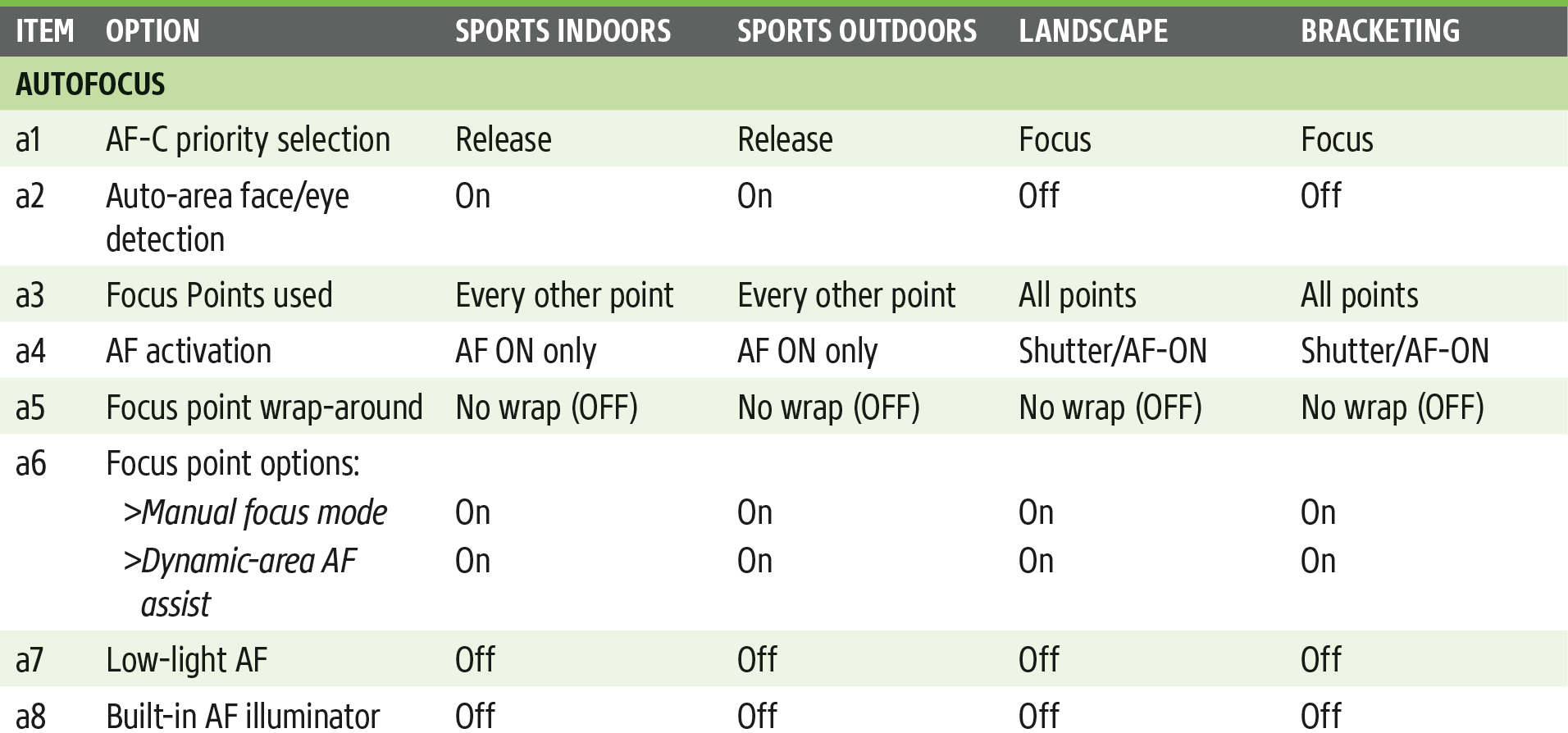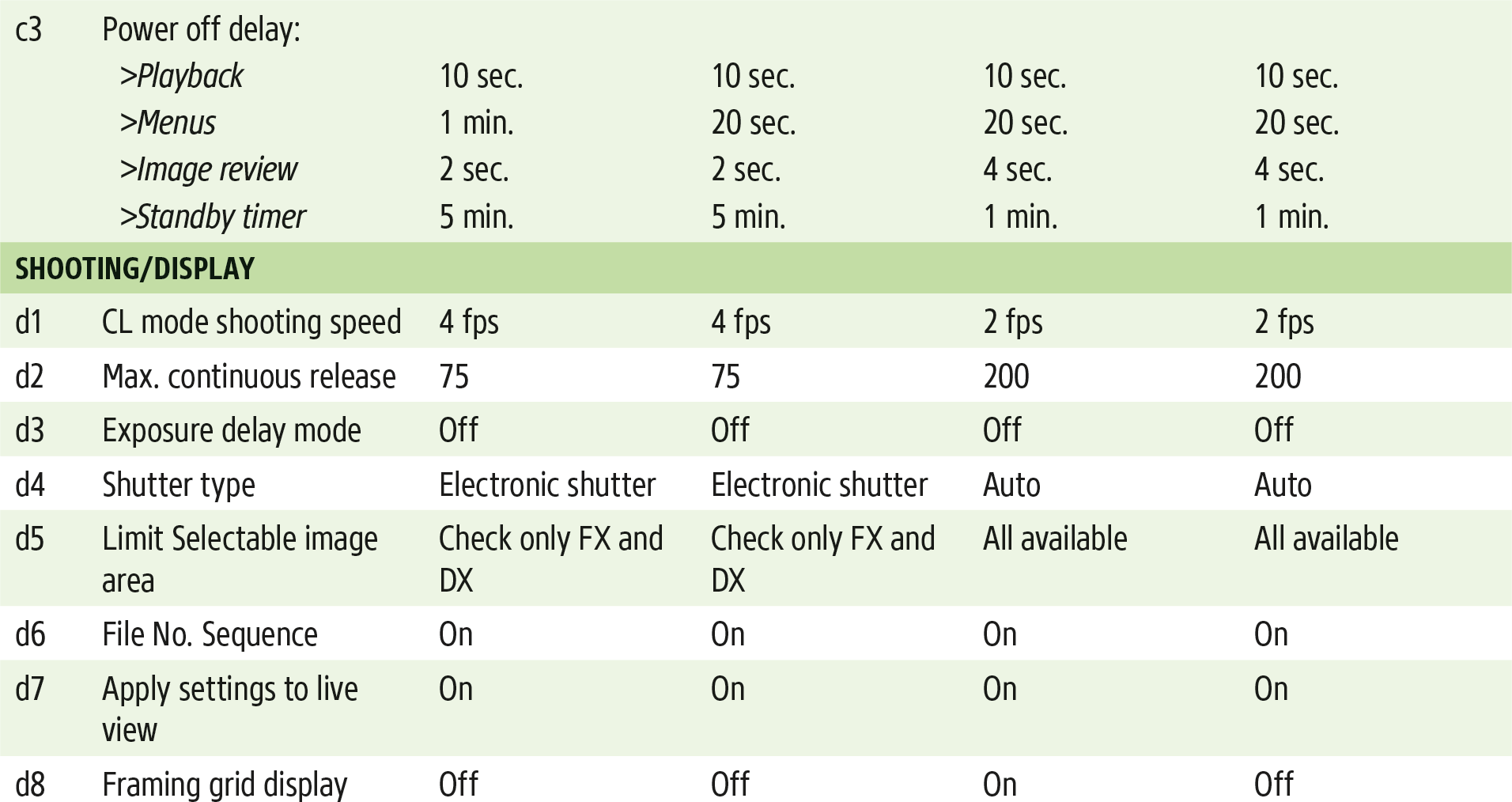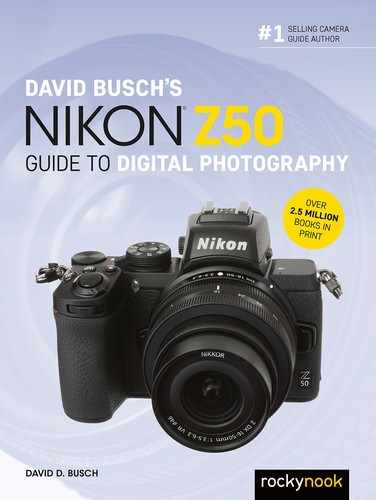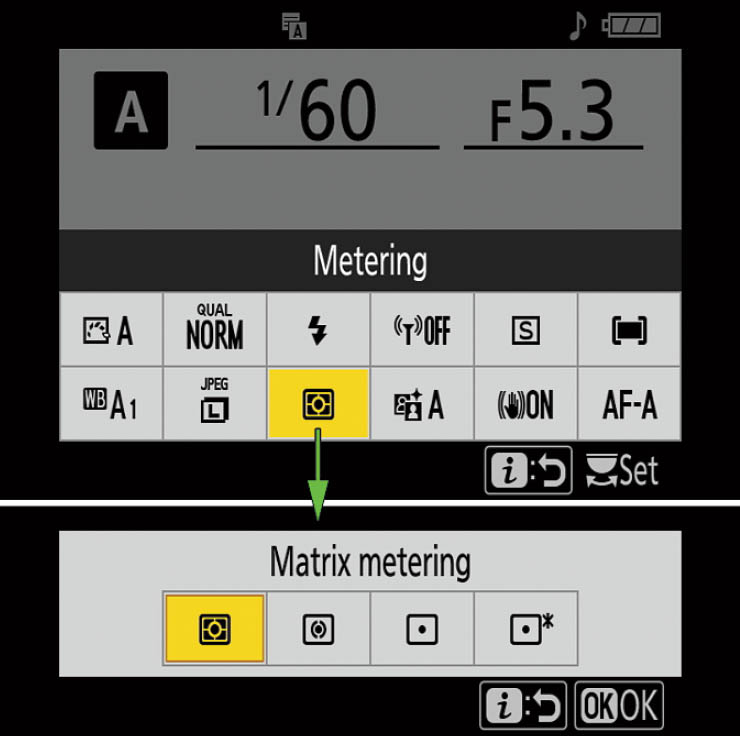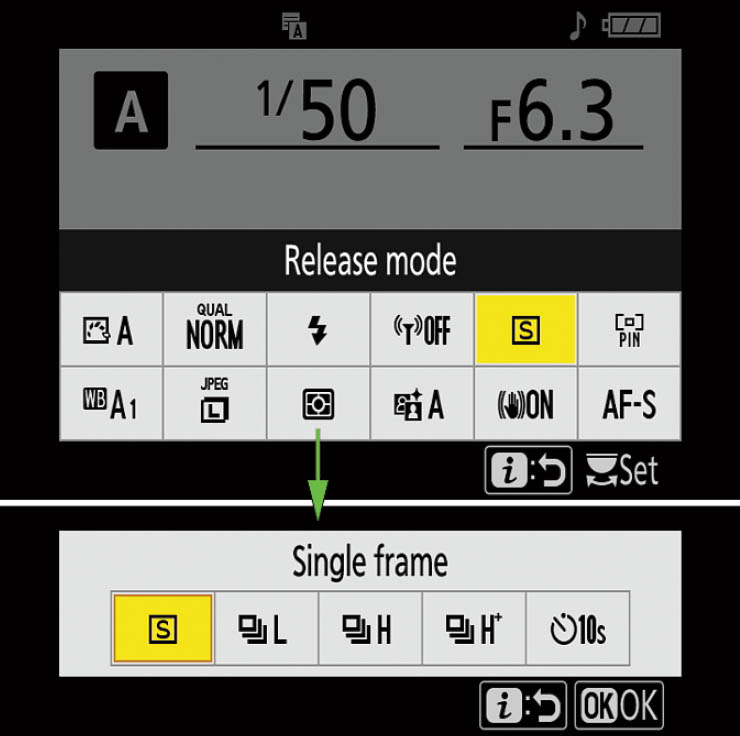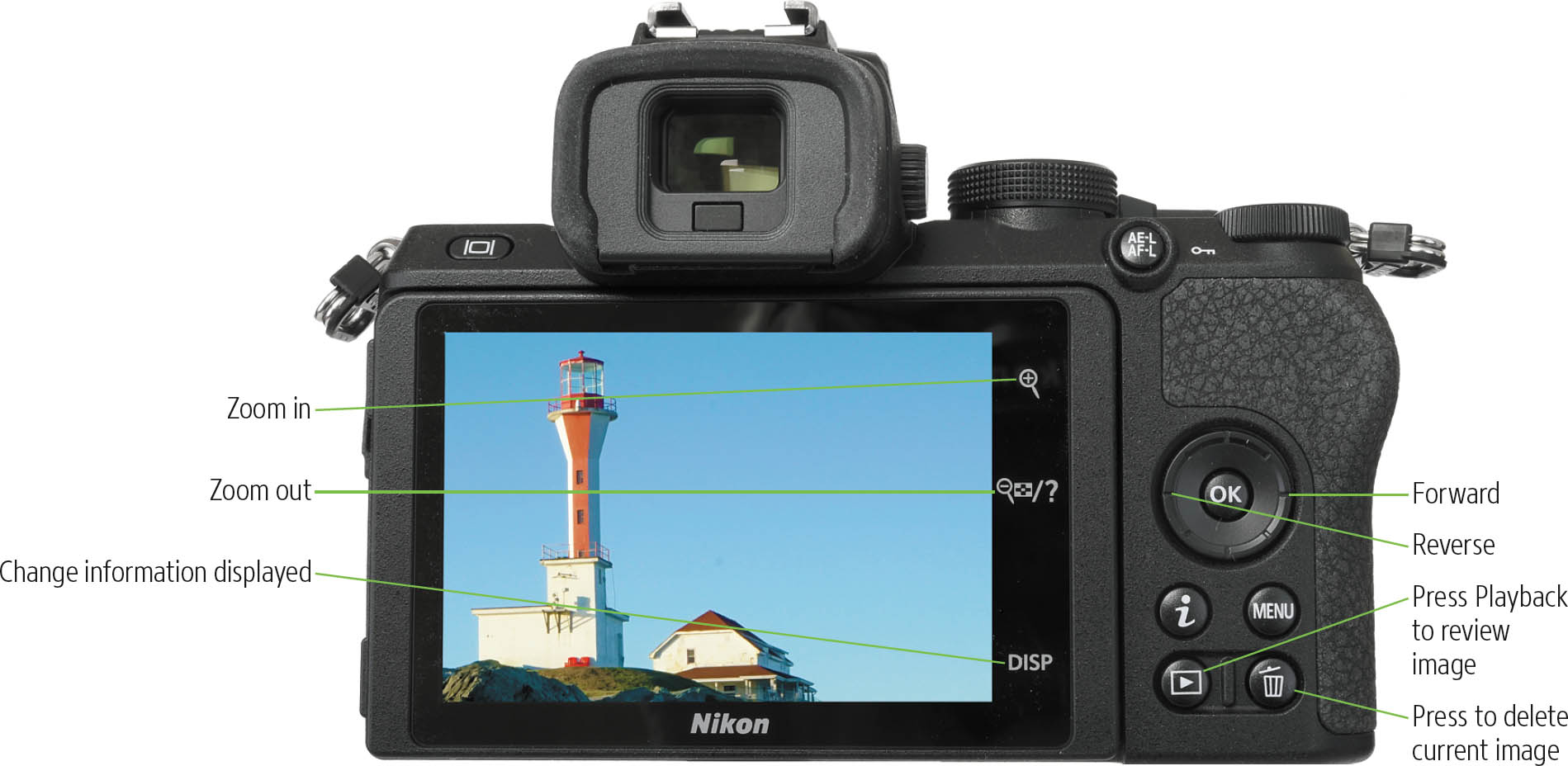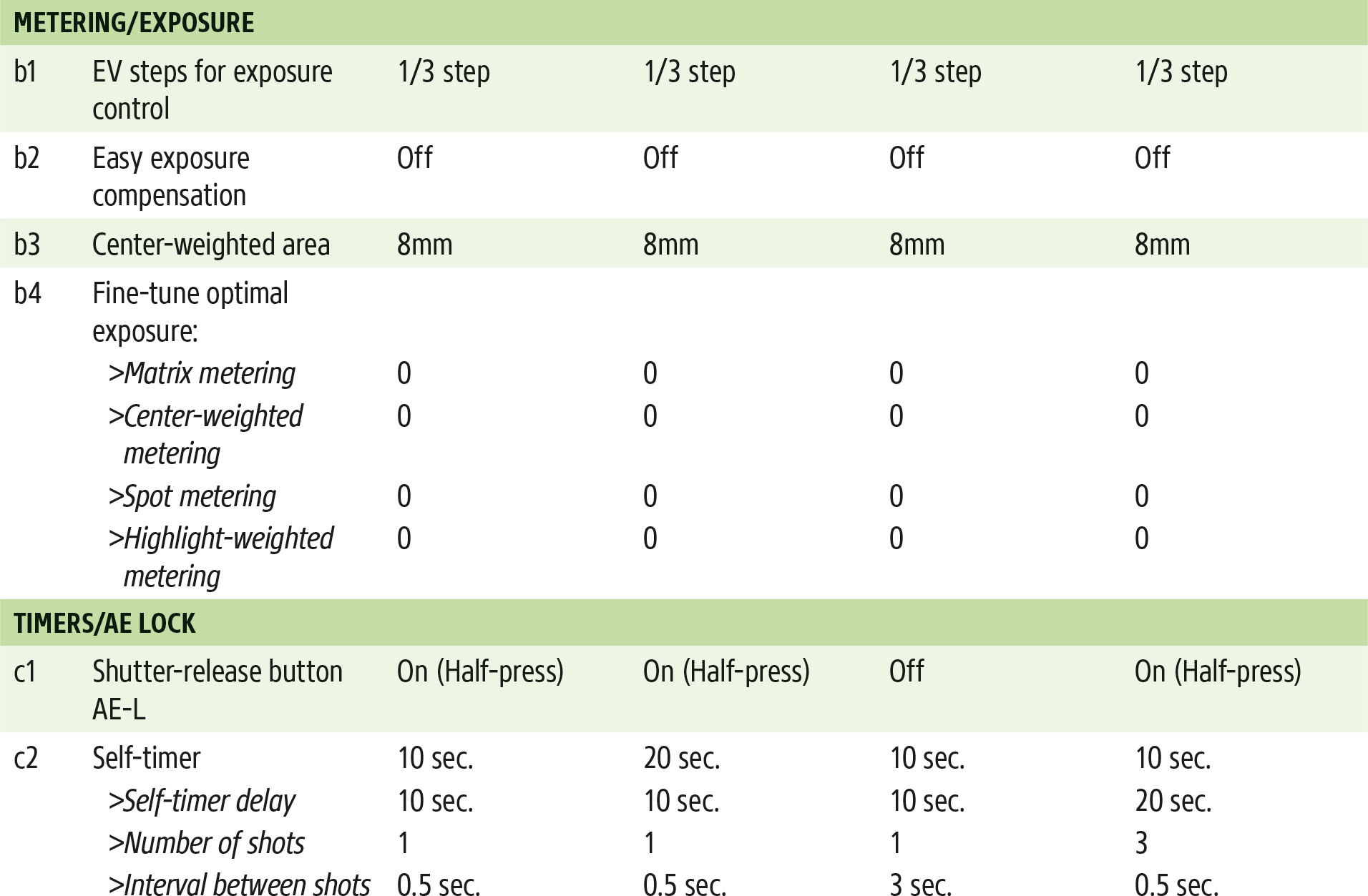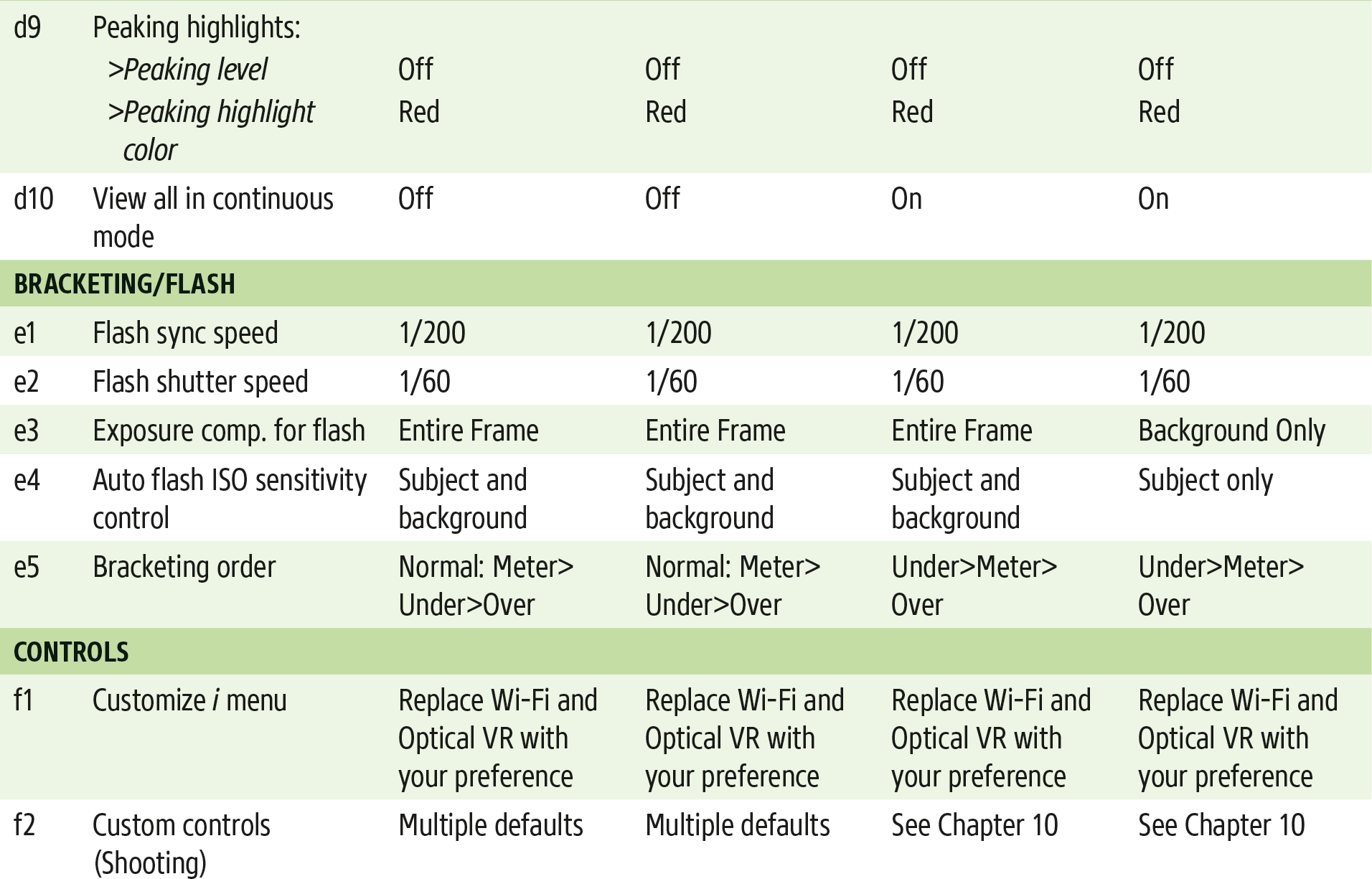You’ll find that it takes only a few minutes to learn the basics of operating your new Nikon Z50, and I’ll give you everything you need to begin taking great pictures in this chapter. If you’ve mounted a lens and inserted a fresh, fully charged battery as I explained in the last chapter, you’re ready to begin. Power your camera up—the On/Off switch is on the right side, concentric with the shutter release button. All you need to do next is select an exposure mode, a metering mode, a focus mode, and a release mode. But first, you’ll want to learn how to switch from the electronic viewfinder to the rear-panel LCD monitor, and back again.
SWITCHING FROM VIEWFINDER TO MONITOR
The Z50 has a sensor located just below the viewfinder window. When it detects you’ve brought the camera up to your eye, the Z50 switches its display from the LCD monitor to the viewfinder, and then back again when you remove the camera from your eye. You can change this default behavior, as I’ll explain in Chapter 3, or manually switch between them using the Monitor Mode button located on the back of the camera to the immediate left of the viewfinder “pentaprism” hump. (See Figure 2.1.)
Selecting an Exposure Mode
This section shows you how to choose an exposure mode. If you already understand exposure modes, jump to the next section on choosing a metering mode.
The Nikon Z50 has one full Auto mode (marked with a green camera icon on the mode dial located on the right shoulder of the camera). It’s more likely you’ll be working with the four manual and semi-automatic modes including Programmed auto (or Program mode), Shutter-priority auto, Aperture-priority auto, and Manual exposure mode, represented by P, S, A, and M labels on the mode dial. These modes allow you to specify how the camera chooses its settings when making an exposure, for greater creative control. The other positions on the mode dial are User Setting memory registers (U1 and U2) to store preferred settings for quick recall, EFCT (to add special effects as you shoot), and SCN (to summon appropriate settings for various types of special scenes, such as portraits or landscapes).
If you’re very new to digital photography, you might want to set the camera to P (Program mode) and start snapping away. That mode will make all the appropriate settings for you for many shooting situations. If you have more photographic experience, you might want to opt for one of the semi-automatic modes. These, too, are described in more detail in Chapter 4. These modes all let you apply a little more creativity to your camera’s settings. To set the exposure mode, hold down the mode dial lock release button, and rotate the mode dial. (See Figure 2.1.) I’ll explain User Settings, Special Effects, and Scene modes later in this book.
- P (Program). This mode allows the Z50 to select the basic exposure settings, but you can still override the camera’s choices to fine-tune your image, while maintaining metered exposure, as I’ll explain in Chapter 4.
- S (Shutter-priority). This mode is useful when you want to use a particular shutter speed to stop action or produce creative blur effects. Choose your preferred shutter speed by rotating the main command dial when the meter is active, and the Z50 will select the appropriate f/stop for you.
- A (Aperture-priority). Choose when you want to use a particular lens opening, especially to control sharpness or how much of your image is in focus. Specify the f/stop you want using the sub-command dial when the meter is “awake” (tap the shutter release to activate the meter, if necessary), and the Z50 will select the appropriate shutter speed for you.
- M (Manual). Select when you want full control over the shutter speed and lens opening, either for creative effects or because you are using a studio flash or other flash unit not compatible with the Z50’s automatic metering when using an attached electronic flash. Use the main command dial and sub-command dial when the exposure meter is active to specify the shutter speed and f/stop (respectively).
Figure 2.1 Mode dial settings.
Choosing a Metering Mode
This section shows you how to choose the area the Z50 will use to measure exposure, giving emphasis to the center of the frame or to highlight areas; evaluating many different areas of the frame; or measuring light from a small spot in the center of the frame.
The metering mode you select determines how the Z50 calculates exposure. You might want to select a particular metering mode for your first shots, although the default Matrix metering is probably the best choice as you get to know your camera. I’ll explain when and how to use each of the four metering modes later. To change metering modes, press the i button (located to the right of the LCD monitor) and use the multi selector directional buttons to navigate to the Metering icon, third from the left in the bottom row. When it’s highlighted, you can rotate either command dial to select one of the choices listed below, or press the OK button and select from a display like the one shown at the bottom of Figure 2.2. I’ll discuss selection of all types of metering in Chapter 4:
- Matrix metering. The standard metering mode; the Z50 attempts to intelligently classify your image and choose the best exposure based on readings from the sensor.
- Center-weighted metering. The Z50 meters the entire scene, but gives the most emphasis to the central area of the frame, measuring about 8mm (by default; you can choose full-frame averaging instead, Custom Setting b3, as I’ll describe in Chapter 10).
- Spot metering. Exposure is calculated from a smaller 4mm central spot, about 2.5 percent of the image area, centered on the current focus point.
- Highlight-weighted metering. Despite its icon (a “spot” accompanied by an asterisk), this is not a spot metering variation. Highlight-weighted metering uses a matrix measuring system to emphasize the highlights of an image, retaining detail in the brightest areas.
Figure 2.2 Choose a metering mode from the i menu. Left to right: Matrix, Center-weighted, Spot, and Highlight-weighted metering.
You’ll find a detailed description of each of these modes in Chapter 4.
Choosing a Focus Mode
This section shows how to select when the Z50 calculates focus: all the time (continuously), only once when you press a control like the shutter release button (single autofocus), or manually when you rotate a focus ring on the lens.
You can easily switch between autofocus and manual focus, and, when AF is activated, you can then select the autofocus mode (when the Z50 measures and locks in focus) and autofocus pattern (which of the available autofocus points are used to interpret correct focus). To specify when the Z50 locks in focus, follow these steps:
- 1. Activate focus mode selection. The quickest way to choose a focus mode is to press the Fn2 button on the front of the camera next to the lens (it’s the lower button with the Fn2 label). A screen similar to the one shown in Figure 2.3 appears. The three choices described below (AF-C, AF-S, and AF-A) appear along with MF (manual focus). Rotate the main command dial while holding down the Fn2 button to select a mode. Note that you can also change focus modes using the i menu described earlier, or the Focus Mode entries in the Photo Shooting and Movie Shooting menus. Some lenses have an AF/MF switch that only allow toggling between autofocus and manual focus.
- 2. Choose focus mode. The autofocus modes and manual mode available in still and movie shooting modes are as follows :
- (AF-C) Continuous-servo autofocus. This mode, sometimes called continuous autofocus, sets focus when you partially depress the shutter button (or other autofocus activation button), but continues to monitor the frame and refocuses if the camera or subject is moved. However, this mode defaults to release priority, which means that when the shutter is pressed down all the way, the Z50 takes a picture, even if precise focus has not been achieved. That’s your best bet for photographing sports and moving subjects, when you’d rather prefer to get the shot even if it’s not in perfect focus. You can change AF-C to focus priority (delay shooting until focus is achieved), Custom Setting a1, as described in Chapter 10.
- (AF-S) Single-servo autofocus. This mode, sometimes called single autofocus, locks in a focus point when the shutter button is pressed down halfway (there are other autofocus activation button options, described in Chapter 13). The focus will remain locked until you release the button or take the picture. If focus is not achieved when the shutter button is pressed down all the way, this setting’s focus priority will delay taking the picture until your subject is focused. This mode is best when your subject is relatively motionless.
- (AF-A) Automatic autofocus. This mode starts out in AF-S mode and will lock focus when the shutter button is pressed down halfway, but will switch to AF-C mode if your subject starts to move.
- (AF-F) Full-time AF. This mode is available only when you are using Movie mode (the Photo/Movie selector lever next to the mode dial is set to the Movie position). The Z50 focuses continually, without the need to press the shutter release button halfway. When the release button is pressed halfway, the focus point turns from red to green and focus is locked.
- (MF) Manual focus. You have total control over focusing, using the focus ring on the lens. This choice is excellent for selecting the exact plane of focus, and works well with non-moving subjects.
Figure 2.3 Choose a focusing mode (bottom row, left to right): AF-A, AF-S, AF-C, or MF.
Choosing the Focus Area Mode
The Nikon Z50 uses up to 209 different focus points to calculate correct focus automatically, using one or more points selected automatically by the camera, or chosen by you. I’ll show you exactly where these focus areas are located in Chapter 5. To choose a focus area mode, follow these steps:
- 1. Activate Focus Area selection mode. Press the Fn2 button as described above, and the screen shown earlier in Figure 2.3 appears.
- 2. Rotate the sub-command dial. Rotate either the sub-command dial on the front of the camera to Pinpoint-AF (available in AF-S focus mode only), Single-point AF, Dynamic-area AF (available in AF-C focus mode only), Wide-area AF (Small), Wide-area AF (Large), or Auto-area AF. I’ll describe each of these next.
- 3. Choose AF-area mode. For now, you should set to Auto-area AF (Auto) and allow the Z50 to choose the focus zone for you. Release the Fn2 button to confirm and exit.
The AF-area modes are as follows. You’ll find more information in Chapter 5.
- Pinpoint-AF (AF-S only). The camera uses a small point to calculate focus. Use this for precise focus on a specific area.
- Single-point (AF-S or AF-C). The camera focuses on a point you select, using the multi selector directional buttons or sub-selector joystick. This mode is good for non-moving subjects.
- Dynamic-area (AF-C only). You select the focus point, but if the subject moves from the selected area, it will use information from the surrounding points. It’s often the best AF-area mode for moving subjects.
- Wide-area AF (Small). Calculates focus from a larger area than Single-point AF, and is best for stationary subjects that occupy more space in the frame.
- Wide-area AF (Large). Calculates focus from an even larger zone, and can achieve accurate focus on subjects that may be located in a wider area of the frame.
- Auto-area AF (AF-S or AF-C). The Z50 chooses a focus point without input from you, rapidly detecting likely subject matter, especially humans. If a portrait subject is detected, faces will be indicated by a yellow border. You can automatically track them by pressing the OK button.
Selecting a Release Mode
This section shows you how to choose from Single frame, Continuous (low speed, high speed, or high speed [extended]), and Self-timer. Unless you have need of burst shooting or the self-timer, you can set your camera to Single frame mode and skip this section.
The shooting mode determines when (and how often) the Z50 makes an exposure. If you’re a late-comer moving to the interchangeable-lens camera world from a point-and-shoot camera, you might have used a model that labels these options as drive modes, a term that dates back to the film era when cameras could be set for single shot or “motor drive” (continuous) shooting modes. Your Z50 has five release (shooting) modes, described below. I’ll explain all these modes in more detail and provide tips for using them in particular situations in Chapter 4. Just press the i button as described earlier, and when the screen shown at top in Figure 2.4 appears, either rotate the main command dial to choose a release mode direction or press the OK button to view the array of choices seen at the bottom of the figure.
Figure 2.4 Choose a release mode from the i menu.
The release modes are as follows:
- Single frame. In single frame mode, the Z50 takes one picture each time you press the shutter release button down all the way. If you press the shutter and nothing happens (which is very frustrating!), you may be using AF-S, a focus mode that requires sharp focus to be achieved before a picture can be taken. This is called focus-priority, and was discussed in more detail under “Choosing a Focus Mode,” earlier in this chapter.
- Continuous L. This “low-speed” shooting mode can be set to produce bursts of between 1 to 4 frames per second, at your option. When Continuous L is highlighted, rotate the sub-command dial on the front of the camera to select your frame rate. You can also set a default frame rate for Continuous L in Custom Setting d1.
I use this setting when slicing a scene into tiny fragments of time isn’t necessary or desirable (say, I’m bracketing in multi-shot bursts, or don’t want a zillion versions of a scene that really isn’t changing that fast). Custom settings are explained in more detail in Chapter 10. In continuous low-speed and high-speed mode (described below), the viewfinder and LCD monitor update in real time while shooting is underway, so you are always looking at the actual image you are capturing.
My recommendation: I find continuous low speed, set to 2 fps, to be particularly useful for street photography and photojournalism applications. Because the speed is so slow, you can use it like single frame most of the time and capture a single image by pressing the shutter release once and then lifting your finger. But if you find a subject that merits a more rapid-fire approach, you can keep the shutter release pressed down, and fire off several shots sequentially. That’s faster than switching from single to continuous mode, and you can avoid the intrusive, distracting “machine gun” approach.
- Continuous H. This mode fires off shots at up to 5 fps, and you can’t change this frame rate to some other value, as you can with the continuous low-speed setting. However, the frame rate can slow down as your Z50’s memory buffer fills, which forces the camera to wait until some of the pictures you have already taken are written to the memory card, freeing up more space in the buffer. The frame rate may also decrease when you’re using the Z50’s electronic shutter, or mechanical shutter speeds slower than 1/200th second, when using high ISO or Auto sensitivity settings, small apertures, when vibration reduction is active, or when some other operations force the Z50 to work at a slightly slower interval.
- Continuous H (Extended). This setting has a fixed setting of roughly 11 fps when shooting in JPEG or 12-bit NEF (RAW) modes, and 9 fps when capturing 14-bit NEF (RAW) files. (The frame advance rate can slow down given the constraints listed above.) At the speedy top rate, the Z50 does not update exposure between frames: it’s locked at the exposure setting for the first frame of a sequence. You may notice some lag in the viewfinder/monitor displays, which may not show the exact current image being captured. Flicker reduction is ignored, and you can’t use flash in this release mode. (Your flash could not recycle fast enough to keep pace!)
- Self-timer. If you want to set a short delay before your picture is taken, you can use the self-timer. When self-timer is highlighted, you can press the down button and choose delays of 2s, 5s, 10s, or 20s, as well as the number of shots taken after the delay. You can also choose these parameters in the Self-timer entry of the Photo Shooting menu (as described in Chapter 11).
Once the self-timer has been selected as the release mode, press the shutter release to lock focus and start the timer. The self-timer lamp on the front of the camera will blink and the beeper will sound (unless you’ve silenced it in the menus) until the final two seconds, when the lamp remains on and the beeper beeps more rapidly.
![]()
TIP If you plan to dash in front of the camera to join the scene when working with the self-timer, consider using manual focus so the Z50 won’t refocus on your fleeing form and produce unintended results. An alternative is to use the ML-L7 Bluetooth remote control. Another is to use the SnapBridge feature of the Z50, which allows you to control your camera remotely from a smart device app running on your iOS or Android phone. I have a special section on using SnapBridge in Chapter 6.
SHOOTING MOVIES
You’ll learn more about shooting HDTV movie clips with your Z50 in Chapter 12. But if you want to get started right away, it’s easy. Just rotate the Photo/Movie selector switch (located on the back of the camera to the immediate right of the viewfinder window) to the Movie position and press the button with the red dot on the top-right panel, southwest of the shutter release button and Off/On switch. Press the button again to stop shooting. That’s it!
Adjusting White Balance and ISO
If you like, you can custom-tailor your white balance (color balance) and ISO sensitivity settings. Your Z50 has dedicated buttons for each (unless you’ve customized your controls to other behaviors).
- ISO. To set the ISO sensitivity, press the ISO button on the top-right shoulder of the camera, located just southeast of the shutter release button. Then rotate the main command dial to select a value. To start out, it’s best to set ISO to ISO 200 for daylight photos, and to ISO 400 for pictures in dimmer light. (Don’t be afraid of ISO 1600 or even higher, however; the Z50 does a much better job of producing low-noise photos at higher ISOs than earlier generations.)
- White balance. You can adjust white balance now by pressing and holding down Fn1, the default White Balance button on the front of the camera to the right of the lens and rotating the main command dial until A0, A1, or A2 appear. Then, with the button still held down, rotate the subcommand dial, if necessary, to select A0 (Keep White/Reduce Warm Colors), which is the default auto white balance setting, and your best option to start out. I’ll explain your other choices, which include Natural Light Auto, Direct Sunlight, Cloudy, Shade, Incandescent, six varieties of fluorescent-style illumination, Flash, Color Temperature, and Preset manual custom balances.
Reviewing the Images You’ve Taken
Read this section when you’re ready to take a closer look at the images you’ve taken, and you want to know how to review pictures and zoom in.
The Nikon Z50 has a broad range of playback and image review options, and I’ll cover them in more detail in Chapter 9. For now, you’ll want to learn just the basics. Here is all you really need to know at this time, as seen in Figure 2.5:
- View image. Press the Playback button (marked with a white right-pointing triangle) at the lower right of the back of the camera to display the most recent image on the LCD monitor.
- View additional images. The fastest way to scroll among images is to flick a finger left or right on the touch screen while an image is displayed. Alternatively, you can press the multi selector left or right to review additional images. Press right to advance to the next image, or left to go back to a previous image.
- Change information display. Tap the DISP label in the control area of the touch screen, or press the multi selector button up or down to change among overlays of basic image information or detailed shooting information. To choose which information displays are shown, activate the ones you want to see using the Playback Display Options entry in the Playback menu, as described in Chapter 9.
- Change magnification. Tap the Zoom In icon in the control area of the touch screen repeatedly to zoom in on the image displayed; the Zoom Out icon reduces the image. A thumbnail representation of the whole image appears in the lower-right corner with a yellow rectangle showing the relative level of zoom. At intermediate zoom positions, the yellow rectangle can be moved around within the frame using the multi selector.
- Exit image review. Press the Playback button again, or just tap the shutter release button to exit playback view.
Figure 2.5 Review your images.
Transferring Photos to Your Computer
The final step in your picture-taking session will be to transfer the photos you’ve taken to your computer for printing, further review, or image editing. Your Z50 allows you to print directly to PictBridge-compatible printers and to create print orders right in the camera, plus you can select which images to transfer to your computer. I’ll outline those options in Chapter 9.
I always recommend using a card reader attached to your computer to transfer files, because that process is generally a lot faster and doesn’t drain the Z50’s battery. However, you can also use a cable for direct transfer, which may be your only option when you have the cable and a computer, but no card reader (perhaps you’re using the computer of a friend or colleague, or at an Internet café).
To transfer images from the camera to a Mac or PC computer using the USB cable:
- 1. Turn off the camera.
- 2. Pry back the lower cover that protects the Z50’s USB port on the left side of the camera, and plug the USB cable furnished with the camera into the USB port. (See Figure 2.6.)
- 3. Connect the other end of the USB cable to a USB port on your computer.
- 4. Turn on the camera. The operating system itself, or installed software such as Nikon Transfer or Adobe Photoshop Elements Transfer, usually detects the camera and offers to copy or move the pictures. Or, the camera appears on your desktop as a mass storage device, enabling you to drag and drop the files to your computer.
Figure 2.6 Images can be transferred to your computer using a USB cable connected to this port.
To transfer images from a memory card to the computer using a card reader:
- 1. Turn off the camera.
- 2. Open the memory card door and extract the SD card containing your photos.
- 3. Insert the memory card into your memory card reader. Your installed software detects the files on the card and offers to transfer them. The card can also appear as a mass storage device on your desktop, which you can open and then drag and drop the files to your computer.
Changing Default Settings
This section is purely optional, especially for true beginners, who should skip it entirely for now, and return when they’ve gained some experience with this full-featured camera. This section is for the benefit of those who want to know now some of the most common changes I recommend to the default settings of your Z50. Nikon has excellent reasons for using these settings as a default, covered earlier in the chapter in the “Selecting a Release Mode” section; I have better reasons for changing them.
Even if this is your first experience with a Nikon interchangeable-lens digital camera, you can easily make a few changes to the default settings that I’m going to recommend, and then take your time learning why I suggest these changes when they’re explained in the more detailed chapters of this book. I’m not going to provide step-by-step instructions for changing settings here; I’ll give you an overview of how to make any setting adjustment, and leave you to navigate through the fairly intuitive Z50 menu system to make the changes yourself.
Resetting the Nikon Z50
If you want to change from the factory default values, you might think that it would be a good idea to make sure that the Nikon Z50 is set to the factory defaults in the first place. After all, even a brand-new camera might have had its settings changed at the retailer, or during a demo. Unfortunately, Nikon doesn’t make it easy to reset all settings in the camera to their factory defaults. In fact, there are no fewer than four different menu resetting options, each of which does slightly different things. Those ways include:
- Photo Shooting/Movie Shooting menu reset. The Photo Shooting and Movie Shooting menus each have a reset entry as their first listing. You’ll zero out the changes you’ve made to the default options. You can view the settings and their defaults in Chapter 9.
- Custom Settings menu reset. The Custom Settings menu also has a separate Reset Custom Settings option that zeroes out most of the changes you’ve made to the default options to Custom Settings menu entries. The default values are listed in Chapter 10.
- Setup menu reset. The Reset All Settings entry in the Setup menu, will restore almost all the camera’s settings to their factory defaults, including Copyright information and IPTC presets, but not Language or Time Zone/Date information. Before doing this type of reset, it’s a good idea to save your settings to a memory card using the Save/Load Settings entry in the Setup menu. As most Setup menu entries are camera configuration items rather than operational options, I won’t be recommending preference changes for them in this chapter. The default Setup menu settings can be found in Chapter 11.
- Reset user settings. As you’ll learn in Chapter 11, you can store specific groups of settings in the U1 and U2 user setting positions on the mode dial. You’ll find a Reset User Settings option in the Setup menu.
Photo Shooting Menu, Movie Shooting Menu, Custom Settings Menu, and User Settings Reset
If you’d like to reset all the options in the Photo Shooting, Movie Shooting, Custom Settings menus, or User Settings, follow these steps:
- 1. Access menus. Press the MENU button located on the right back panel of the Z50.
- 2. Choose Photo Shooting, Movie Shooting, Custom Settings, or Setup menus. Press the multi selector down button to scroll down to the Photo Shooting menu (represented by a still camera), the Movie Shooting menu (represented by a movie camera icon), or the Custom Settings menu (represented by a pencil icon). Press the right multi selector button to reveal the Photo Shooting, Movie Shooting, Custom Settings, or Setup menus.
- 3. Access Reset. Use the down button to scroll to the entries labeled Reset Photo Shooting Menu, Reset Movie Shooting Menu, Reset Custom Settings, or Reset User Settings in their respective menus, then press the right button.
- 4. Reset. For the menus, you’ll be presented immediately with the option of choosing Yes or No to reset the respective menu. Highlight Yes and press OK. For User Settings, you can choose to reset U1 or U2 individually.
- 5. Repeat. If you want to reset other menus or user settings, repeat steps 3 and 4.
- 6. Exit. When finished, press MENU or tap the shutter release to exit.
Recommended Default Changes
Although I won’t be explaining how to use the Nikon Z50’s menu system in detail until Chapter 9, you can make some simple changes now. These general instructions will serve you to make any of the default setting changes I recommend next. To change any menu setting, follow these steps:
- 1. Access menus. Press the MENU button located below the multi selector on the back panel.
- 2. Choose the main menu you need to access. Press the multi selector down button to scroll down to the menu containing the entry you want to change. The available menus include (from top to bottom in the left column of the menu screen): Playback menu (right-pointing triangle icon); Photo Shooting menu (still camera icon); Movie Shooting menu (movie camera icon); Custom Settings menu (pencil icon); Setup menu (wrench icon); Retouch menu (paintbrush icon); and My Menu (text page/text page with checkmark icon).
- 3. Select main menu. Press the right multi selector button to choose the menu heading containing the submenu entry you want to change.
- 4. Choose menu entry. Press the down multi selector button to move within the main menu to the entry you want to change. A scroll bar at the right side shows your progress through the menu, as all the main menus except for the Custom Settings menu and My Menu (if it contains fewer than five custom entries) have more items than can fit on a single screen.
- 5. Choose options. Press the right multi selector button to choose the highlighted menu entry, and view a screen with options. Select the options you want, and press OK to confirm. Some menus allow you to confirm by pressing the right button again, or require you to select and confirm Done before exiting.
- 6. Exit menus. Usually you can exit the menu system by pressing the MENU button. If an option has variations, I’ll explain them when I discuss each of the menu choices in Chapters 9, 10, and 11.
Nikon does an excellent job with specifying default values, but here are some of the changes I recommend you make to the defaults that Nikon sets up for you. There are only a few, and I have no changes to recommend for the Playback and My Menu settings, which are fine the way they are for most people, nor for the Retouch menu (which doesn’t have parameters that can be stored).
Here are my suggestions for the Photo Shooting menu entries listed:
- Image Quality. Change from JPEG Normal to JPEG Fine, to produce better image quality. (The star indicates least compression, and best quality.)
- High ISO NR. The default is Normal, and, if you want the minimum amount of grainy visual noise in your images, resist the temptation to change it. Wait until you’ve had a chance to evaluate whether the Z50 performs to your liking at high sensitivity settings. Off produces the least amount of noise reduction, but also doesn’t degrade the amount of detail as much as any of the On settings.
- Auto ISO sensitivity control: Maximum sensitivity. This entry is located within the ISO Sensitivity Settings entry of the Photo Shooting menu. The default value for the Z50 is a lofty 51200. You should lower it to ISO 6400 or below. New users of this camera shouldn’t want to allow the camera to select a higher value until they’ve had a chance to decide if images at settings higher than ISO 6400 are acceptable to them. It’s better to be unable to take pictures at all in very dim light than to end up with excessively grainy images when the Z50 chooses an ISO setting automatically that isn’t acceptable.
Recommendations for the Movie Shooting menu:
- Auto ISO sensitivity control: Maximum sensitivity. The default value for movie shooting is also 25600. You should lower it to ISO 6400 or below, for the reasons described above.
- High ISO NR. The default value for movie shooting is Normal (not Off, as for still shooting). Nikon reasons that noise reduction, with an accompanying loss of detail, is more acceptable with video because each frame is viewed for only a fraction of a second. While that is true, I do recommend you turn it off, at least temporarily, and shoot some test video and then compare to video with noise reduction set to Normal to see which best suits your needs.
Make these changes to the Custom Settings and Setup menu entries listed:
- Custom Setting c3: Power Off Delay: Standby timer. If you shoot sports or other events where you don’t want the camera going to sleep and delaying your ability to snap off a shot now, change from the default 30 seconds to 5 minutes or 10 minutes. You’ll use more power, but won’t lose a shot from a split-second delay while the camera wakes up.
- Setup menu: Slot empty release lock. This controls what happens when you press the shutter release while no memory card is loaded in the camera. Make sure no one has changed this setting to OK: Enable Release. Make sure it is set to LOCK: Release Locked. Why would you want to be able to take pictures with no memory card in the camera, other than to demonstrate the camera or a few other reasons? Even though a DEMO label appears on the LCD monitor when you “take” pictures with no memory card inserted, it’s easy to overlook.
Shooting Tips
I’m ending this chapter with some tips on settings to use for different kinds of shooting, including recommended settings for some Photo Shooting and Custom Setting menu options. You can set up your camera to shoot the main type of scenes you work with, then use the tables that follow to make changes for other kinds of images. Most will set up their Z50 for my basic settings, and adjust from there. I’m not going to provide recommendations for every menu setting, as many are simply personal preferences that don’t apply to everyone. If you see a listing missing, it’s because the setting should be made to your preference. Chapters 9, 10, and 11, provide more detailed recommendations.
Photo Shooting Menu Recommendations
I’ll list my Photo Shooting menu suggestions first, in Tables 2.1 and 2.2. The Custom Setting menu recommendations are divided into the exact same categories but, of course, deal with different options. In Table 2.1, the second column shows the default settings, as the Z50 comes from the factory. (I have no specific recommendations for the Movie Shooting or Setup menus.)
TABLE 2.1 Photo Shooting Menu Recommendations #1

TABLE 2.2 Photo Shooting Menu Recommendations #2

Custom Setting Menu Recommendations
Next come the Custom Setting menu recommendations—Tables 2.3 and 2.4. They are divided into the exact same categories. And, of course, they all deal with different options. I don’t have any recommendations for CSM g Movie Settings, which assigns functions for movie shooting only; your preferences will depend entirely on what kind of video you capture.
TABLE 2.3 Custom Setting Menu Recommendations #1


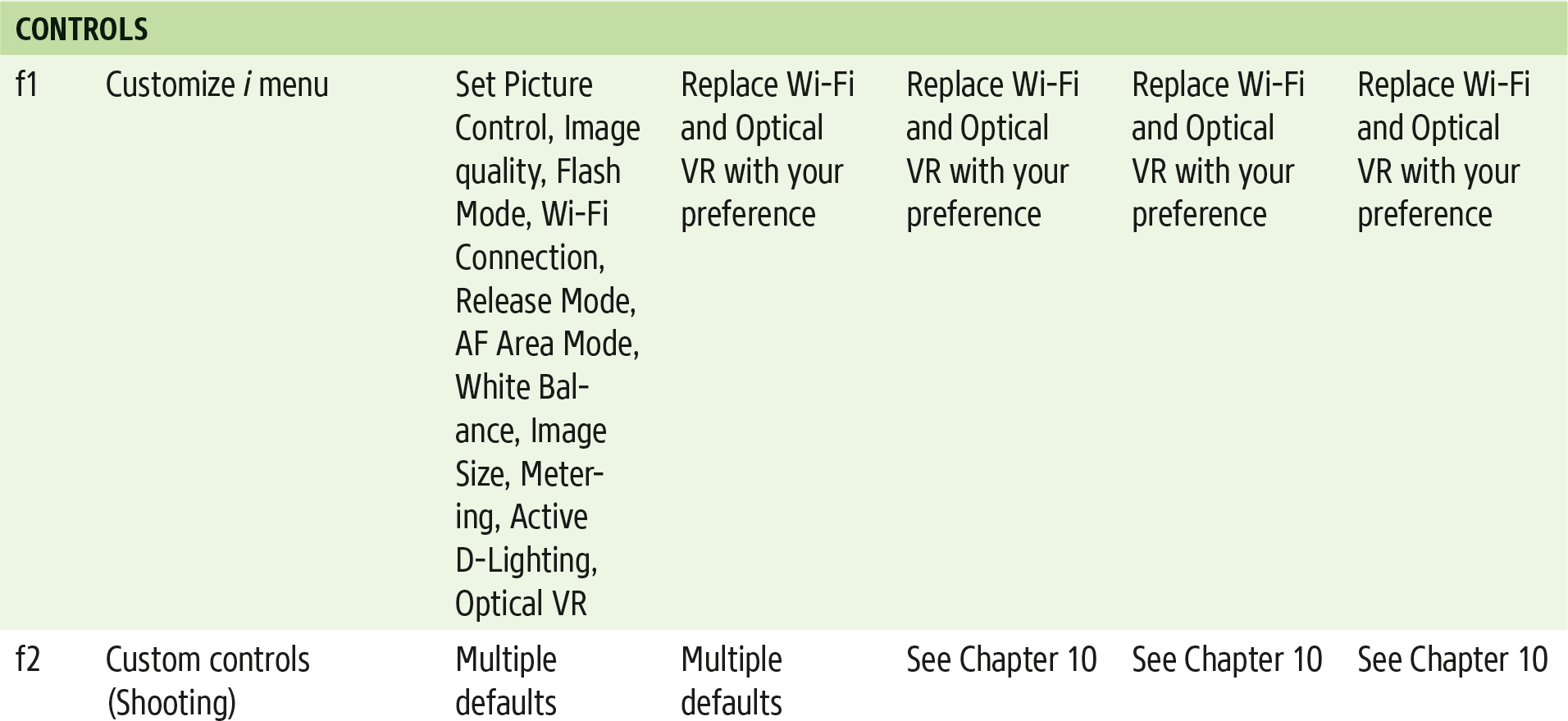
TABLE 2.4 Custom Setting Menu Recommendations #2
